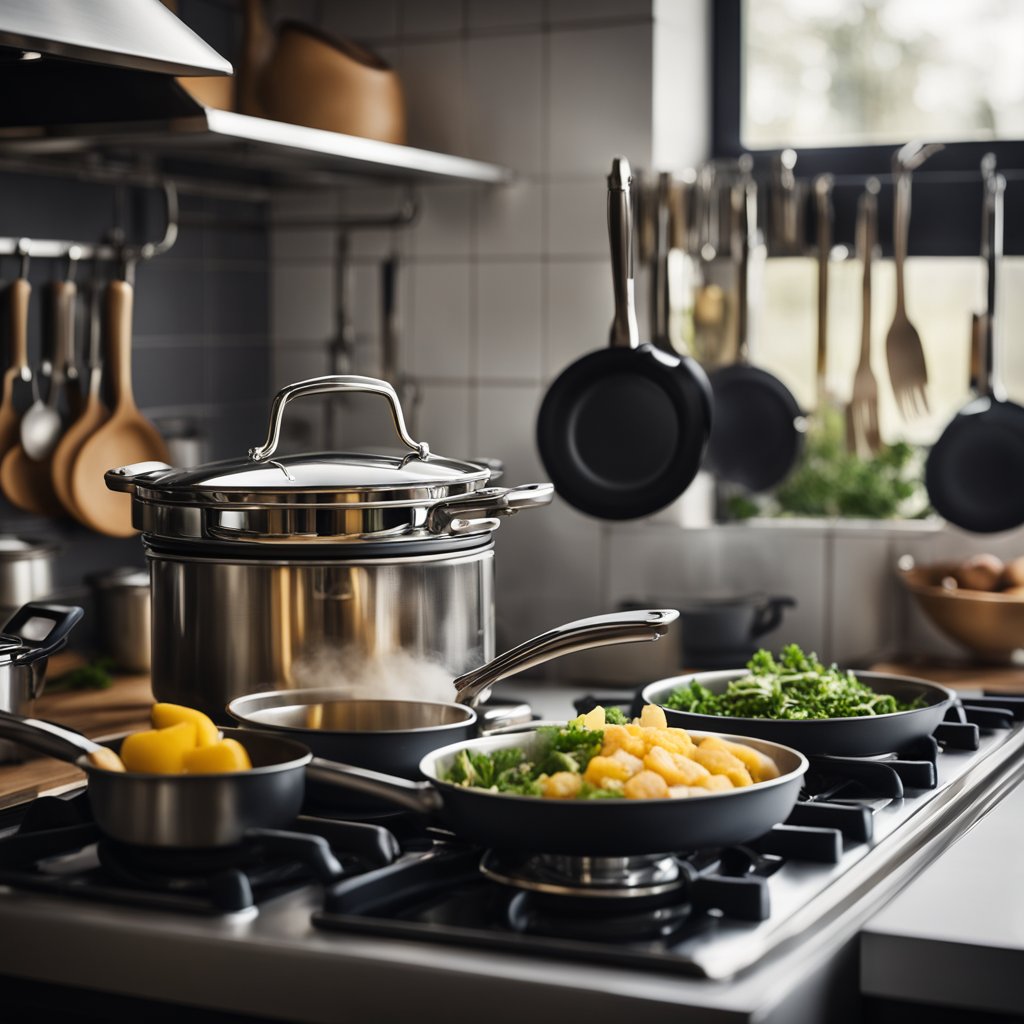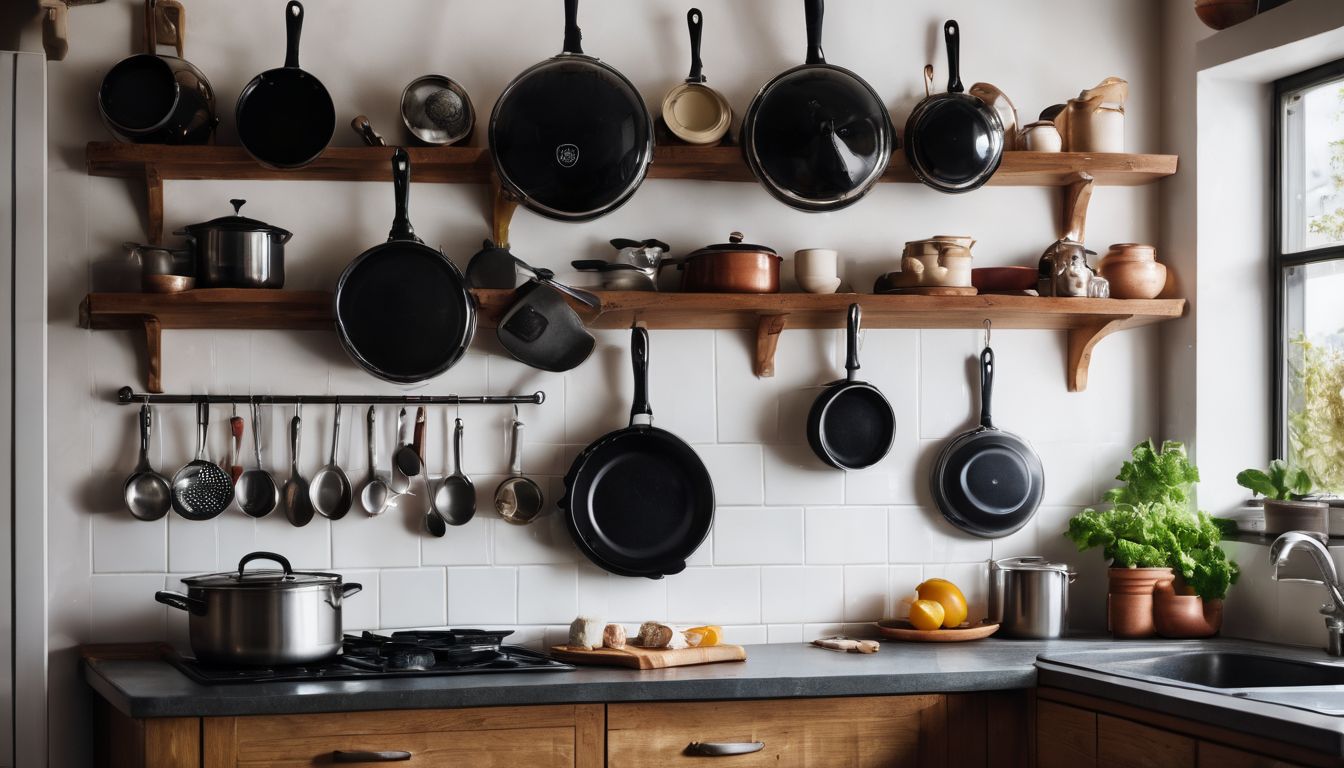This post contains affiliate links. See the affiliate disclaimer here.
Frustrated with your ceramic pans not lasting as long as you hoped? Ceramic cookware, loved for its nonstick qualities, typically lasts between 2 to 5 years. In this article, we’ll reveal tips on keeping those pans in tip-top shape for years to come.
Discover the secret to durable cookware!
Key Takeaways
- Ceramic pans usually last between 2 to 5 years, but with proper upkeep, they can exceed that timeline.
- Keep ceramic pans away from high heat and avoid using metal utensils on them to prevent scratching and maintain the nonstick surface.
- After use, clean your ceramic cookware with warm soapy water and a soft sponge; steer clear of abrasive cleaning agents that can damage the pan.
- Regular inspection for signs like warping, scratches, chips, or loose handles helps you know when it’s time to replace your pans for safety and performance reasons.
- To circumvent thermal shock and potential cracking, allow your ceramic pans to gradually cool before washing or putting them on cold surfaces.

The Lifespan of Ceramic Cookware
Ceramic pans can last anywhere from 2 to 5 years with proper care and usage. However, high-quality ceramic cookware can potentially last even longer, up to 10 years or more.
Average lifespan
The average lifespan of ceramic pans can vary, but typically they last anywhere from one to five years. It depends on how often you use them and how well you take care of them. High-quality ceramics may even surpass this range if maintained properly.
They are known for their nonstick surfaces which need tender love and care to keep performing optimally.
Cookware material lifespan is important for home cooks who want the best tools in the kitchen. Nonstick pan durability plays a crucial role here since nonstick doesn’t mean forever stick-free.
Regular wear and tear will eventually degrade any cookware’s performance, so knowing when it’s time to replace your items is key for maintaining a functional kitchen space.
Quality ceramics
When choosing ceramic cookware, prioritize high-quality ceramics to ensure durability and longevity. Inferior quality ceramics may degrade quickly, leading to chips, scratches, and loss of nonstick properties.
Look for reputable brands known for using high-grade materials in their ceramic pans to invest in kitchen essentials that will last.
Quality ceramics are designed to withstand daily use and maintain their nonstick surface over time. High-quality materials also contribute to better heat distribution and retention, making cooking more efficient.
Signs It’s Time to Replace Your Ceramic Pans
If you notice warping, scratches, sticking food, difficult cleaning, or loose/rusty handles on your ceramic pans, it may be time to consider replacing them. These signs can indicate that the nonstick coating has worn down and the pan is no longer safe or effective to use.
Warping
Ceramic pans can warp when exposed to sudden temperature changes. If the pan is heated too quickly or if it’s cooled down rapidly, warping may occur. The best way to prevent this is by allowing the pan to cool down naturally before washing it with cold water.
Avoid exposing the hot ceramic pan directly to a cooler surface or immersing it in cold water immediately after cooking.
To maintain the structural integrity of your ceramic pans and avoid warping, handle them with care and take measures to prevent rapid temperature changes during cooking and cleaning.
Scratches or chips
Small scratches or chips on ceramic pans can compromise their nonstick surface, making them prone to food sticking and difficult to clean. It’s essential to inspect your ceramic pans regularly for any signs of damage and replace them if you notice significant scratching or chipping.
Using metal utensils or abrasive cleaning tools should also be avoided as they can contribute to the deterioration of the pan’s coating, leading to a shorter lifespan.
To prevent scratches and chips, consider using silicone or wooden utensils when cooking with ceramic pans and opt for gentle cleaning methods such as soft sponges or cloths. Additionally, storing your ceramic pans properly by avoiding stacking them can help minimize the risk of accidental damage.
Sticking food
If food sticks to your ceramic pans, it may be a sign that the nonstick coating is deteriorating. Prevent this by using low or medium heat and applying a small amount of oil or cooking spray.
Avoid using metal utensils that can scratch the surface, as scratches can cause food to stick. Proper cleaning after each use is essential in maintaining the nonstick properties of your ceramic pans.
To prevent sticking, make sure to follow the manufacturer’s guidelines for care and maintenance. Additionally, consider investing in silicone or wooden utensils to protect the nonstick coating and extend the lifespan of your ceramic pans.
Hard to clean
Ceramic pans can become hard to clean over time if food particles and oils are not properly removed after each use. To prevent this, soak the pan in warm, soapy water for a few minutes before gently scrubbing with a non-abrasive sponge or cloth.
Avoid using harsh cleaning agents or abrasive scrubbers, as they can damage the nonstick surface of the pan.
Regularly cleaning ceramic pans after each use can prevent food residue from building up and making it difficult to clean. By following proper care and maintenance instructions, you can ensure that your ceramic pans remain easy to clean and maintain their nonstick properties for an extended lifespan.
Loose or rusty handles
Loose or rusty handles on ceramic pans can be a sign of wear and tear, affecting the overall usability and safety of the cookware. Loose handles may increase the risk of dropping hot food or liquids, posing a potential hazard in the kitchen.
Rusty handles not only affect the appearance of the pan but also compromise its cleanliness and hygiene. Regular inspection and maintenance are essential to address these issues promptly, ensuring that your ceramic pans remain safe and functional for longer.
Regularly tighten loose handles with suitable tools to prevent accidents in the kitchen. Additionally, keep an eye out for any signs of rust on the handles and promptly address them using appropriate cleaning methods or consider replacing the pan if necessary.
How to Extend the Lifespan of Ceramic Pans
Proper cleaning and care are essential for extending the lifespan of ceramic pans. Avoid using high heat, metal utensils, thermal shock, and harsh cleaning agents to preserve the nonstick surface.
Proper cleaning and care
To ensure the longevity of your ceramic pans, it’s essential to clean them properly and with care. After each use, hand-wash the pans with a soft sponge or cloth in warm, soapy water.
Avoid abrasive cleaners that can damage the nonstick surface. If there are stubborn food residues, soak the pan before cleaning to make it easier.
Regular maintenance also involves avoiding cooking sprays as they can leave a residue that is difficult to remove. Instead, opt for using a small amount of oil or butter when necessary.
Avoid using high-heat
To ensure your ceramic pans last longer, avoid using high heat. Excessive temperatures can cause the ceramic coating to break down over time, leading to reduced nonstick properties and a shorter lifespan for your cookware.
Using medium or low heat settings will help preserve the integrity of the ceramic surface, allowing you to enjoy nonstick cooking for an extended period.
Additionally, consistently exposing ceramic pans to high heat can lead to discoloration and damage to the pan’s exterior. By being mindful of the temperature settings when cooking, you can maintain the quality and longevity of your ceramic cookware while ensuring safe and effective use in your kitchen.
Avoid using metal utensils
To maintain the longevity of your ceramic pans, refrain from using metal utensils. Metal utensils can scratch the nonstick coating on ceramic cookware, leading to its deterioration over time.
Instead, opt for silicone, nylon, or wooden cooking utensils to protect the integrity of the nonstick surface and prolong the lifespan of your ceramic pans.
Using metal utensils can compromise the durability and performance of your ceramic cookware. By avoiding metal utensils and opting for gentler alternatives, you can ensure that your nonstick pans retain their effectiveness and last longer in your kitchen arsenal.
Avoid thermal shock
To maintain the quality of your ceramic pans, it’s crucial to avoid subjecting them to thermal shock. Rapid temperature changes can cause ceramic cookware to crack or shatter. When transferring a hot pan from the stove to a cold surface, such as running it under cold water or placing it on a damp countertop, be cautious as these actions may result in thermal shock and damage the pan.
Preventing thermal shock is essential for preserving the longevity of your nonstick cookware. By being mindful and handling your ceramic pans with care when transitioning between different temperatures, you can ensure their durability and extend their lifespan.
Avoid harsh cleaning agents
To maintain the quality of your ceramic pans, avoid using harsh cleaning agents. Strong chemicals and abrasive cleaners can wear down the nonstick coating and damage the surface of the pan, shortening its lifespan.
Instead, opt for gentle dish soap and a soft sponge to clean your ceramic pans thoroughly without causing any unnecessary wear and tear. Additionally, consider soaking stubborn stains before gently scrubbing them away with a non-abrasive brush.
Proper care and maintenance are crucial in extending the lifespan of your ceramic pans. By taking simple steps like avoiding harsh cleaning agents, you can ensure that your cookware remains in top condition for years to come.
Conclusion: Is Investing in Ceramic Pans Worth It?
In conclusion, the lifespan of ceramic pans can be extended with proper care and maintenance. By avoiding high heat, using gentle cleaning agents, and refraining from thermal shock or metal utensils, you can ensure your ceramic pans last longer.
Taking these steps is essential in ensuring that investing in ceramic pans is worth it for their durability and nonstick qualities.
FAQs
1. How long can I expect my ceramic pan to last?
Typically, a ceramic pan’s lifespan ranges from two to five years, but this can be longer if you follow proper nonstick cookware care and maintenance tips.
2. What are some ways to extend the life of my ceramic pans?
To make your ceramic cookware last longer, use gentle utensils, avoid high heat, clean them with soft sponges, and store them properly away from other kitchen tools that could scratch them.
3. When should I think about replacing my nonstick ceramic pan?
Consider replacing your ceramic nonstick pan if its surface gets scratched or starts to lose its nonstick quality after regular cooking and cleaning practices have been followed.
4. Is it safe to keep using a damaged nonstick pan?
It’s best not to use a damaged nonstick pan because scratches on the surface might make the food stick or potentially release particles from the coating into your food.
5. Can maintaining my ceramic pans compare in longevity with stainless steel cookware?
With careful maintenance, such as avoiding metal utensils and harsh scouring pads, a well-kept ceramic pan can offer remarkable durability close to that of stainless steel cookware.

